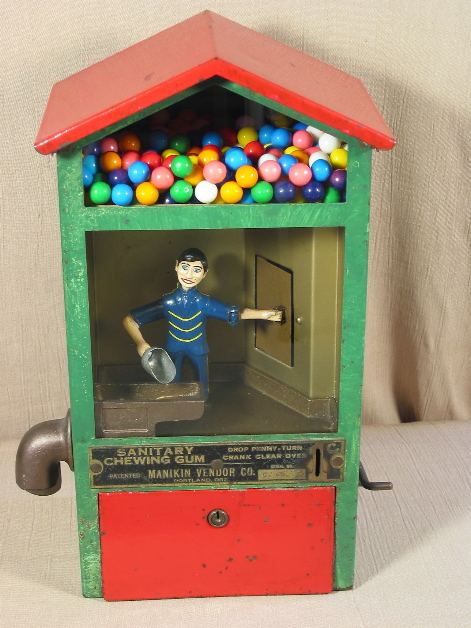___________________________________________________________________________________________
Manikin Vendor

___________________________________________________________________________________________

Manikin Vendor Co., Portland, OR, c. 1929, 16". This is an animated vendor similar to---but earlier than---the A. M. Company's Scoopy. This has a clockwork mechanism inside, but rather than a permanently wound spring it uses the energy imparted by the customer to wind the clockwork mechanism enough for one play. You insert a penny and rotate the handle a half-turn toward the back of the machine. The character then pivots to his left, opens the oven door, allows a gumball to drop into his scoop, and then pivots back to the right and drops the gumball into the trough.
Several variations of this model involved the case or the character. These are pictured and described in some detail in Silent Salesmen Too, page 89. One version had round portholes high on each side, and the other had a short manufacturer's tag instead of the machine-width tag on the machine pictured above. Of these variations, I've seen only 2 with portholes and one with a short tag, and the one with a short tag was also one of the 2 with portholes. These features are considered earlier than the full-width tag and solid sides found on the vast majority of Manikins.
Characters were the baker boy, the black baker, the bell hop, the Indian, and the clerk. All of these were cast from the same mold and are therefore the same except for the skin color and simulated clothing. Of these, the baker boy is by far the most common. All others are far less common, but I'm not aware of a hierarchy of rarity amongst the less common characters.
I've seen several Manikins for sale with a black baker as the character, but when you look closely you can tell that the black baker was created by recently repainting a white baker. It gives a whole new meaning to "diversity," but don't be fooled by it. There's a substantial price difference between an original black baker and a common white baker, and that difference is far more than the cost of the small bottle of model paint used to create one from the other.
When I lived in Southern California I learned from several collectors and non-collectors that these used to be used all over Knott's Berry Farm, which lies on the border of Orange and Los Angeles counties. The non-collectors who told me this were folks who saw the machine in my house---or in one case while I was actually buying the machine at an antique store---and said nostalgically that they remembered seeing them there.
The example pictured above is 100% original except for 2 things: 1) It's been converted to a nickel machine, and 2) The paint on the outside of the case is a very old repaint. The blue paint shows soft brush strokes while the orange paint shows none, so it's possible that the orange paint is original. All interior paint, including that on the bell boy, appears to be original.
This is not the nicest Manikin I've seen, but I've passed up chances at nicer cases because I don't want to give up the bell boy character and I don't want to merely swap him into a nicer case. Given the look of this machine, where I bought it, and what I paid for it, I believe that this machine exists now as it existed when it was removed from service. I don't want to part it out, and I like the soft, old look of the case even though it's an old repaint and is not original. I'd rather it hadn't been converted to a nickel machine, but it was done long ago and is part of the machine's history by now. I'm happy with it as it is.
___________________________________________________________________________________________
___________________________________________________________________________________________
©Small Vintage Vending 2003-2009